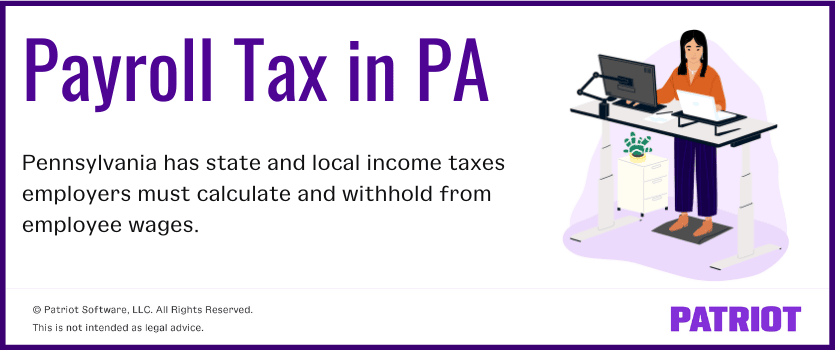Payroll tax in Pennsylvania is notoriously difficult, confusing, and overwhelming for new and veteran employers alike. And when it comes to payroll, you probably don’t want to waste time making preventable payroll mistakes.
To help simplify PA employment tax, we’ve put together the following article to review your employer responsibilities. And, we’ve provided plenty of resources you can use to get more information.
Federal employment tax overview
Before we get into Pennsylvania payroll taxes, let’s go over employment taxes at the federal level.
Regardless of what state you do business in or have employees in, you’re responsible for withholding the following federal taxes from employee wages:
- Federal income tax
- Social Security tax (employers must also contribute a matching amount)
- Medicare tax (employers must also contribute a matching amount)
But as you know, federal taxes aren’t the only taxes you withhold from employee paychecks. Most (but not all) states also have state income taxes, and many have local income taxes.
Pennsylvania is a state with both state and local income taxes.
Payroll tax in Pennsylvania
Did you know that Pennsylvania is home to more than one million small businesses and 2.5 million employees? And with so many employees working in the state comes many employers running payroll.
Again, Pennsylvania has a state income tax employers must withhold from employee wages. And, the state has a local earned income tax (EIT) you’re responsible for, along with a local services tax (LST) you may be responsible for. The PA payroll tax rate for these local taxes varies by location.
We’ll unravel the state PA payroll tax and local taxes below.

Pennsylvania state income tax
State income tax (SIT) is a tax employees pay on their wages. As an employer, you’re responsible for calculating and withholding the tax from your employees’ taxable wages. After withholding the tax, you must remit it to the the Pennsylvania Department of Revenue.
You must withhold state income tax from an employee’s wages if they’re a:
- Resident employee who performs services within or outside Pennsylvania
- Nonresident employee who performs services in Pennsylvania
So, what is the PA payroll tax rate for state income tax withholding? The PA state employment tax rate is 3.07%.
Registration
Before you begin running payroll for employees, register your business with the state to obtain a state income tax account.
You can register online through the PA Online Business Entity Registration (PA-100).
Tax remittance due dates
How frequently you need to remit employee tax withholdings depends on the amount. Check out the following remittance schedule to find your due dates:
| Deposit Frequency | Due Date | Tax Withholding Amount |
|---|---|---|
| Quarterly | The last day of April, July, October, and January | Use this frequency if your total withholding is under $300 per quarter |
| Monthly | 15th day of the following month | Use this frequency if your total withholding is $300 – $999 per quarter |
| Semi-monthly | Within 3 banking days of the close of the semi-monthly period | Use this frequency if your total withholding is $1,000 – $4,999.99 per quarter |
| Semi-weekly | If you pay employees on a Wednesday, Thursday, or Friday: Wednesday following the pay date
If you pay employees on a Saturday, Sunday, Monday, or Tuesday: Friday following the pay date |
Use this frequency if your total withholding is $5,000 or greater per quarter ($20,000 per year) |
How to pay PA tax
You can file tax returns and pay withheld income tax using one of the following methods:
- Online using e-TIDES
- By phone using TeleFile
- Third-party software (e.g., Patriot Software’s payroll)
For more information about Pennsylvania state income tax withholding, check out the state’s website.
Pennsylvania local income taxes
The Pennsylvania Department of Community and Economic Development handles local income taxes. Employers with worksites in Pennsylvania are responsible for withholding and remitting Pennsylvania local income taxes. Worksites include factories, warehouses, branches, offices, and residences of remote employees.
Again, PA has two local taxes:
- Earned Income Tax (EIT): All employees working in Pennsylvania must pay a local earned income tax.
- Local Services Tax (LST): This local tax only applies to certain locations.
But before we get into EIT and LST, let’s look at your general employer responsibilities regarding local income taxes.
Pennsylvania advises employers to take the following steps to determine their local income tax withholding requirements:
- Look up PSD (political subdivision) codes and tax rates: The PSD is a 6-digit number that identifies location and helps determine your employee’s local tax rate. Use Pennsylvania’s Address Search Application to look up PSD codes and EIT and LST rates. Be sure to save the report for your records. Use this report information to help you complete forms in the next step.
- Complete forms:
- Fill out the Residency Certification Form for each employee. Save a copy of each form for your records.
- Register your business online with the correct local agency or using the Employer Registration for Local Earned Income Tax Withholding form to obtain your local tax ID number.
Earned income tax
As a Pennsylvania employer, you must use each employee’s completed Residency Certification Form to determine their EIT rate. How you do this depends on whether the employee:
- Lives and works in PA: Compare the “Total Resident EIT Rate” (the municipality where the employee lives) to the “Work Location Non-Resident EIT Rate” (where the employee works). Withhold the higher of the two.
- Works in PA but lives outside of PA: Out-of-state resident employees are subject to the “Work Location Non-Resident EIT Rate.”
You must file and remit withheld taxes within 30 days of the end of each calendar quarter. Do not follow this deadline if you have multiple worksites and have elected to remit to a single tax collector (you must file and remit monthly).
Not a Pennsylvania employer? If you have an employee who lives in PA but works in another state, you are not responsible for completing the Residency Certification Form. You can, however, withhold the employee’s “Total Resident EIT Rate” as a courtesy. If you decide not to, let the employee know (they’ll need to handle this on their own).
For more information on earned income tax, check out the state’s website.
Local services tax
If you have worksites within an LST taxing jurisdiction, you must deduct the tax from employees at the site of employment.
Use the Official Tax Register to determine if the tax is listed in your area. Don’t see your municipality’s and/or school district’s tax rates? You are not required to withhold the LST.
You must file and remit withheld taxes within 30 days of the end of each calendar quarter. If you have both a municipal and school tax, and if the combined tax rate exceeds $10, withhold it together and remit to the municipality.
Not all employees are subject to LST withholding. Generally, employees whose total earned income is lower than $12,000 are exempt if the LST exceeds $10. Do not withhold local services tax for the year from an employee’s wages if they give you an upfront exemption form. However, you must restart withholding the tax if your locality tells you to, the employee tells you they are no longer eligible, or if you pay the employee more than $12,000 for the year.
For more information on local services tax, check out the state’s website.
Don’t let manual payroll tax calculations slow you down. Patriot’s payroll software guarantees accurate tax calculations. Want us to handle your federal, state, and local tax filings and remittance, too? Sign up for our Full Service Payroll. Get your free trial of either product today!
This is not intended as legal advice; for more information, please click here.



